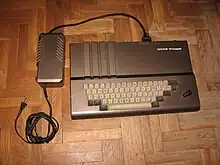Videoton TV-Computer
The TV-Computer (or TVC in short) is an 8-bit home computer which was manufactured by the Hungarian company Videoton around 1986. The computer was based on the Enterprise and had a built-in BASIC interpreter. Programs could be loaded via tape[3] or floppy. It had a built-in joystick and a keyboard with Hungarian letters and nine function keys.
 A Videoton TVC home computer main unit and power supply | |
| Also known as | TVC |
|---|---|
| Developer | Videoton |
| Manufacturer | Videoton[1][2] |
| Type | home computer |
| Release date | around 1986 |
| Units sold | around 12000 |
| Operating system | TVC OS, UPM, BASIC |
| CPU | Zilog Z80 compatible |
| Memory | 32/64 kilobyte |
| Graphics | 128×240/16 colors, 256×240/4 colors, 512×240/2 colors (b&w) |
There are three different models of the TVC:
- 32k which has 32 Kb of RAM
- 64k which has 64 Kb of RAM
- 64k+ which has 64 Kb of RAM and a newer BASIC interpreter (v2.2) and more video RAM (64 Kb instead of 16 Kb)
The TVC has three graphical modes: 128×240/16 colors, 256×240/4 colors, and 512×240/2 colors (black and white). There were no text (character display) mode only graphical. This made the computer a bit slow and smooth scrolling is pretty challenging (though there are examples for vertical and horizontal scrolling games nowadays).
Few programs existed for the computer. Many of these were written by dedicated amateurs and were distributed by mail.
It has two tape ports, 1 A/V, 1 RGB monitor, 1 RF connector, 1 centronics printer port, 1 side (for program-modules - game cartridges) and 4 upper (computer internals are almost exposed) expansion ports and 2 joystick ports (compatible with Atari style joys, but may have 2 buttons).
The 4 upper expansion ports made this computer very versatile. The official floppy solution was connected to one of these ports, the RS232 card also was plugged here. The class-room network card also used this port, the planned game card (with sprite capabilities) also would have used this port - unfortunately we just have some pictures about the proto module and some documents mention it. Even a SID card was created, using a SID chip to enhance the TVC sound capabilities.
Current enhancements using these ports are: SD card reader, sound card (with 3 different sound chips), game card (+2 joy ports +SN76489 sound chip + 4 built-in games), HDMI output with several FPGA cores (ofc including TVC), USB/PS2 mouse handling (and an unreleased gamecard with SID and sprite support) and many more.
References
- Videoton TV-Computer, Old-Computers.com Museum
- Videoton TVC (TV-Computer) from 1983, MEGA – Museum of Electronic Games & Art
- Videoton TV Computer Tape File Converter, Google code